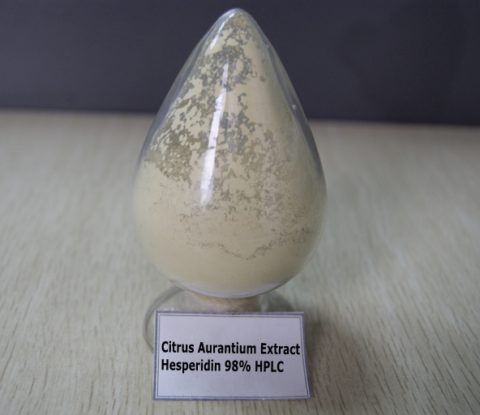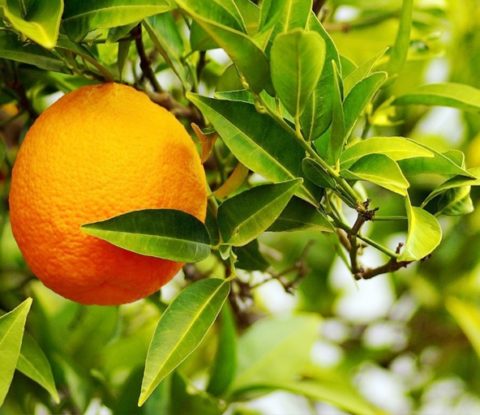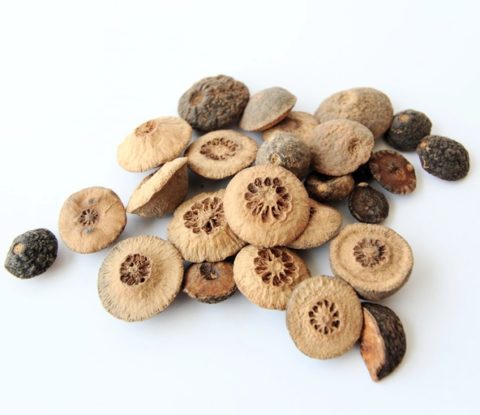
Citrus Aurantium Extract
Hesperidin 98% HPLC
【Product Name】:Citrus Aurantium Extract
【Latin Name】:Citrus Aurantium L.
【Part Used】:Peel
【Extract Solvent】:Ethanol
【Active Ingredient】:Hesperidin
【Specification】:98%
【Test Method】:HPLC
【CAS No】:520-26-3
【Molecular Formula】:C28H34O15
【Molecular Weight】:610.55
【Appearance】:Offwhite or Light Yellow powder
Brief Introduction
Bitter orange, Seville orange, sour orange, bigarade orange, or marmalade orange refers to a citrus tree (Citrus aurantium) and its fruit. It is native to Southeast Asia, and has been spread by humans to many parts of the world. Wild trees are found near small streams in generally secluded and wooded parts of Florida and The Bahamas after it was introduced to the area from Spain.
Hesperidin is a bioflavonoid glycoside commonly found in citrus fruits (most notoriously oranges) and is a sugar-bound form of the flavonoid hesperitin. Hesperitin is known to mediate the actions of hesperidin in the body, and since hesperidin needs to progress to the colon to be ‘released’ by intestinal bacteria it acts as a time-release for hesperitin; one serving of hesperidin seems to increased blood levels for over the course of a day or so when consumed in this manner.
If we are to look currently at the human evidence on orally ingested hesperidin, it appears to promote blood flow (minorly to moderately) and may have a weak influence on blood pressure while it is pretty much ineffective on cholesterol and triglycerides. Not much other human evidence exists aside from the cardiovascular parameters mentioned above, and it seems pretty weak at improving parameters of diabetes as well (with exception to the eyes, diabetic retinopathy, as preliminary evidence suggests that hesperidin is quite protective of them).
That being said, in animal studies oral intake of hesperidin at a dose similar to that used in humans seems to be a very potent cardioprotection agent and is quite protective of the brain in response to various stressors; the protection is antioxidative in nature, but it seems to work through a currently not identified antioxidant responses from the genome. Aside from the protective effects (most notable in the heart and brain, but extend to every organ), hesperidin may be able to reduce a lack of appetite and have minor anti-allergic properties.
Orange peels can actually be used to get the supplemental dosage of hesperidin seen in the human studies, and hesperidin is known to interact with a variety of drug metabolizing enzymes so it should be approached cautiously if also using pharmaceuticals.
Pharmacological Benefits
Hemorrhoids
In a 1994 study in Angiology, a supplement containing a combination of hesperidin and diosmin (another antioxidant compound available in citrus fruits) was found to aid in the treatment of hemorrhoids. For the study, 100 patients suffering from a hemorrhoid attack were treated with either the hesperidin/diosmin combination or a placebo for seven days. Compared to the placebo group, members of the supplement group showed significantly greater improvement in symptoms. More recent research on the use of hesperidin in treatment of hemorrhoids is lacking.
Swelling management
Early research shows that a combination of hesperidin, butcher’s broom, vitamin C and methyl chalcone may reduce swelling of the upper arm. This therapy may last for up to 90 days. Swelling of the arms (lymphedema). Early research suggests that taking a specific product (Cyclo 3 Fort) containing butcher’s broom root extract, hesperidin methyl chalcone, and vitamin C by mouth for 90 days reduces swelling in the upper arm and forearm, and improves mobility and heaviness, in women with swelling of the arm after breast cancer treatment. However, other research shows that taking a specific product (Daflon 500, Les Laboratoires Servier) containing hesperidin and diosmin by mouth does not reduce arm swelling in women following breast cancer surgery.
Diosmin is used almost interchangeably with hesperidin except for treating hot flashes. Hot flashes are treated with hesperidin. In one clinical study, 194 menopausal women who had hot flashes were given a daily nutritional supplement containing 900 mg of hesperidin, 300 mg of hesperidin methyl chalcone, and 1,200 mg of vitamin C. At the end of a month, 53% of the women in the study reported that their hot flashes had stopped and 34% reported that they had improved. This is a better response for controlling hot flashes than is obtained from treatment with Effexor (venlafaxine), black cohosh, red clover, soy isoflavones, or dong quai, although there are other symptoms of menopause that are addressed by those treatments.
Circulation support
Hesperidin’s most significant benefit appears to be supporting healthy circulation, especially in the legs. Poor circulation in the legs (chronic venous insufficiency, CVI). Taking a particular product (Cyclo 3 Fort) containing hesperidin methyl chalcone, butcher’s broom, and vitamin C by mouth seems to relieve the symptoms of poor circulation in the legs. Also, taking a specific product (Daflon 500, Les Laboratoires Servier) containing hesperidin and diosmin by mouth for 2-6 months seems to improve CVI symptoms, although taking the drug Venoruton might be more effective for treating this condition.
Hesperidin and Diosmin for Treating Bruises
Combinations of hesperidin and diosmin are especially useful for treating bruises. Bruises are usually “only a cosmetic concern,” but they can be a major cosmetic concern that causes weeks, months, or even years of embarrassment.
Bruises caused by accidents or trauma usually occur after a specific, memorable event. They tend to have random shapes and sizes. Bruises after intentionally inflicted injury tend to have the shape and size of the instrument used to inflict the injury. When bruises are caused by vitamin C deficiency, or scurvy, there are usually also bleeding gums, bleeding sinuses, and frequent infections.
If you have bruising with inflamed gums or sinusitis, try taking vitamin C with bioflavonoids, at least 2,000 mg per day for a month. Otherwise, take 1,000 mg of diosmin or diosmin with hesperidin every day indefinitely. Diosmin, hesperidin, and citrus bioflavonoids do not interfere with blood thinning medications, which act directly on the blood. Diosmin, hesperidin, and citrus bioflavonoids act on blood vessels and the muscles surrounding them.
Chronic Venous Insufficiency
A condition in which the veins do not efficiently return blood from the legs to the heart, chronic venous insufficiency is linked to problems like varicose veins, ankle swelling, and nighttime leg cramping. Supplements containing a combination of hesperidin, extract of the herb butcher’s broom, and ascorbic acid (a form of vitamin C) may help treat chronic venous insufficiency, according to a 2007 study published in International Angiology. The study involved 124 people with chronic venous insufficiency. Every day for eight weeks, all study members took two capsules of the hesperidin/butcher’s broom/ascorbic acid formula. Starting in the second week of the study, participants showed significant improvements in their symptoms (including pain, cramps, and swelling). The study’s authors suggest that the hesperidin/butcher’s broom/ascorbic acid may help treat chronic venous insufficiency by producing beneficial effects in patients’ blood vessels.






